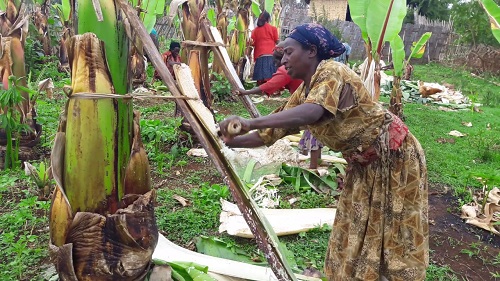
Enset planting is an indigenous farming system, which supports a large proportion of the Ethiopian population. Its production is dominant in the highlands of south and southwestern parts of the country where several important differences in cultural and social organization between regions exist. It ranked as an important cultivated staple food crop. The extent to which it is supplemented by other crops, however, may vary considerably. It is the main food source among the Gurage, the Sidama and related groups. It is not the only staple food as it is used with other tuber crops or cereals in Southern Ethiopia.
Studies indicate that the economic as well as the cultural importance of Enset was first observed by the Scottish traveller James Bruce during his travel to discover the source of the Nile in 1768-1773. He reported that it grows in the west of the Nile, where there are large plantations to produce the food of the people inhabiting that area. Other scholars have also reported that it was once an important food and fiber plant in Upper Egypt. For many years, it was considered a species under the Species Musa. The species name Musa was first detected by the Australian botanist F. Welwitsch.
Enset is native to the highlands of south and southwestern Ethiopia where farmers have countless numbers of varieties. It is also a wild plant in forests, river gorges and streams. The plant consists of a root system and an underground stem structure that has a diversified coloration of green, red, purple, brown or a mixture of green and red. Its leaves are oblong, bright to dark-green, with margins sometimes pale to dark red or dark purple. For optimum growth, the plant requires an average rainfall at a certain temperature. It grows well in most soil types, provided they are sufficiently fertile and well-drained. The ideal soils are moderately acidic to alkaline, with organic matter.
The common method of propagation is by means of suckers originating from the immature plant. Although it is not common, seeds may also be used to produce seedlings in some parts of southern Ethiopia. In the traditional cropping system, it is a common practice to transplant in nursery beds before taking them into the permanent field. Under the traditional production system, depending upon the altitude and management practices, maturation takes some years. Studies indicate that the optimal harvesting time is just after the appearance of stems, stalks and flowers.
Harvesting includes cutting the leaves into pieces, scraping the leaf covers, fermenting and mixing the leaves, and waiting for a certain period of time. The main food product obtained by fermenting the mixture is locally known as “kocho”. Part of the starchy liquid called “bulla” obtained by squeezing the mixture can also be consumed after it is allowed to settle for some days. The freshly cooked form is locally called “amicho” and can be consumed in a similar way as potato. The plant can be harvested at any developmental stage if there is shortage of food. Thus, the plant is considered as a “field bank” for food.
Nutritionally, Enset is rich in carbohydrates, comparable to other starchy products such as sweet potato. The fat and carbohydrate contents of its products are even better compared to sweet potato, but its protein content is extremely low and cannot satisfy the protein requirements. It contains more calcium and iron than most cereals, tubers and root crops. It is a dominant staple food for millions of people. It is cultivated mainly for a starchy human food and livestock feed, although almost every part of the plant can be used in one way or another. The stalk constitutes the most important source of food for humans, whereas the whole part of the plant except the root is used to feed livestock. Its fiber has an excellent structure, and its strength is equivalent to a world-class fiber crop.
The dried leaf is used for packing and wrapping and for fencing and housing construction. The leaf blades are used as a plate for serving cooked foods, for wrapping several kinds of materials such as fermented Enset, butter, coffee and chat to prevent them from drying too much. Local people also believe that it has various medicinal properties. It is also being used as an ornamental plant in Ethiopia and elsewhere. Studies show that it has important ecological functions such as producing organic matter, creating a nutrient reservoir in the soil, controlling erosion, thus contributing to the stability and continuity of farming.
Shortage of rain can only stop the growth but “not” kill the plant, as it has a large accumulation of moisture in its roots and stems. As a result, famine rarely occurs in areas where it is widely grown. Although it has been cultivated as a staple food that sustained the rural population for many years, it has been “neglected” by researchers, development and conservation agents. It cannot be fully marketed but has multipurpose use for subsistence farmers. They produce large quantities of dietary energy and have stable yields under conditions in which other crops fail. Yet, they have hardly come to the attention of the concerned agencies and researchers until recently.
Most of the research, development and conservation work in Ethiopian agriculture had been focused on cereal-based systems. However, in recent years it has been observed that the potential of such type of development is limited; it can only assist farmers working on fertile soils under favorable environmental conditions. To the majority of subsistence farmers who cultivate crops under unreliable environmental conditions, this strategy has caused food insecurity, environmental degradation and loss of valuable genetic diversity. As a result, some Enset growing regions have experienced famine in recent years, something unknown to the past generations.
As a result of population growth, the major Enset growing areas have decreased and traditional cultivation has failed to feed the people who depend on it. As the crop has also a long maturity period, the average daily consumption has reduced. It is suggested to enlarge the farmland to increase supply to meet the food requirement of households. However, there is “little” opportunity in densely populated areas for expansion of cultivable land. The choice is to increase agricultural production through an increase in productivity using improved tech. Although its yield is higher than the yield of cereals, it is far below its yield “potential” because of lack of knowledge about factors that boost its production.
Disease and drought have also threatened its production. Bacterial wilt causes complete death of the plant within weeks after the first symptoms. During drought, when other crops failed to survive, people entirely depend on its harvested. This practice together with the occurrence of diseases caused serious “genetic erosion.” Although the country is rich in genetic diversity of this crop, identification of the best variety that survives in poor environment has not yet been started. Given its contribution to food security in Ethiopia, and its potential for expanded production and its use in other parts of the country, it has recently received some attention.
Despite the attention given to it, Enset-based farming is often poorly understood and faces many problems. The most serious problems are associated with lack of knowledge on the various indigenous cultivation methods. Farm-based agronomy, genetic diversity, diseases and long growth cycle impact its production. A better understanding of these
factors in the growth and development of the plant can help to develop improved agronomic practices. This enhances the use of the existing variety in increasing food security. Moreover, proper understanding and evaluation of the indigenous knowledge and traditional cultural practices can help to design and implement better development programs.
The ultimate objective of research is to develop improved agronomic practices and enhance the use of the existing genetic diversity to bridge the gap between actual and potential yield. This helps to enhance food security and environmental sustainability. The exploration of traditional methods can help to understand how farmers evaluate, utilize and conserve the plant. Investigating the yield potential using physiological parameters and weather data, and comparing it with actual yield provides lessons. Comparing, for example, “kocho” yield with the yield of other starch crops grown in Ethiopia gives some idea of productivity. Studies give general information about the crop, its botany and role in south and southwestern parts of the country.
Studies analyze the current indigenous knowledge on production methods and constraints. They also investigate genetic relationships and identify duplicates with regional variations. As mentioned earlier, Enset has been cultivated as staple food and supported a large proportion of the people in the south and southwestern parts of Ethiopia. Because of population pressure, recurrent drought and persistent diseases, there has been degradation of natural resources. Consequently, the indigenous production system failed to sustain the population. The indigenous production methods and the plant characteristics and environmental factors have to be studied to support the population.
Enset is widely grown in areas where there is a large accumulation of moisture. Even if there is a shortage of rain, it does not stop its growth. This characteristic of the plant keeps famine at bay. It has been proven to be a sustainable supply of food for the people residing mainly in the southern part of the country. Subsistence farmers depend on it as a reliable source of food supply. Despite its importance as a source of large quantities of dietary energy, little or no attention has been given to it.
As mentioned earlier, conservation efforts have been devoted to cereals. It has been observed that farmers are currently working on selected fertile soils to grow crops. Most of the farmers cultivate under unreliable conditions. This leads to food insecurity due to shortage of rain and environmental degradation. Studies show that farmers in Enset growing regions are now facing famine due to decline in production. There is, therefore, a need for appropriate research that enhances production and productivity. A strategy should be devised that encourages farmers with practical participatory experimentation to produce for both household consumption and the market to earn income.
BY GETACHEW MINAS
The Ethiopian Herald June 10/2021




